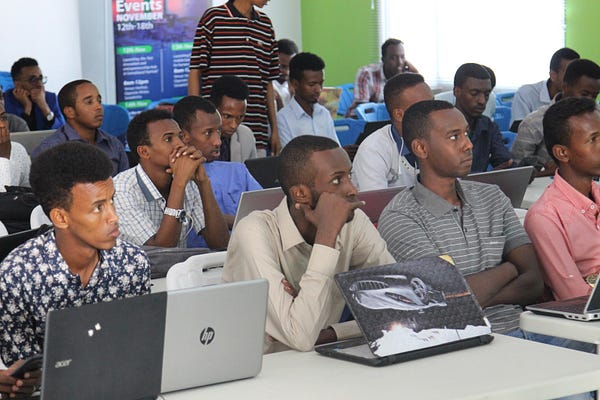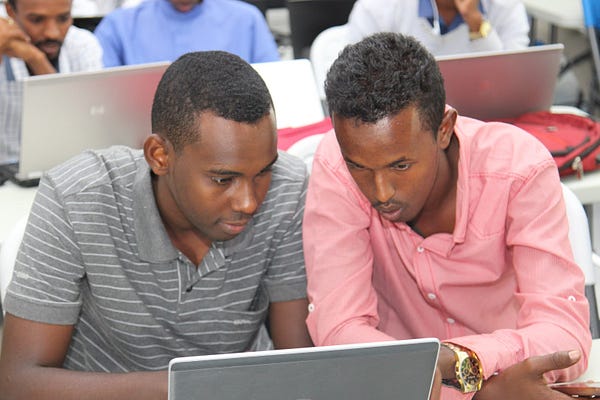TL;DR: I had a pleasure to be a part of the first AI conference in Somaliland, organised by Shaqodoon, HarHub and Elmi Academy, and featuring speakers from Google, MIT, major Somaliland telecoms, banks, University of Hargeisa and Ministry of Telecommunication & Technology of Somaliland. See slides(lectures + workshops) and event program for details. Below are my personal notes and pictures from this trip.
Intro
Whenever I tell this story people seem to be surprised with choice of spending vacation time in Somaliland and running an AI-related event there. So let me share some first-hand experience with you and explain why trips and events like this are useful, fun and safe.
Who am I ??
Currently I work as Machine Learning / NLP Engineer at HubSpot and previously I was at Google for a couple of years using ML and data science to fight spam and abuse in Google products (mostly Search and Chrome). There were a few events I did on machine learning prior to this trip, but they were in Europe (UCL and Sapienza universities). So a bit different from Somaliland.
How it Happened

At the end of 2018 I was thinking on where to go for vacation and the Ethiopia + Somaliland + Djibouti combo appeared to be great weather-wise, rich culturally and definitely exotic. Having seen my friend Tilek recently posting a fun video counting money in Somaliland, I reached out to him on how his trip went.
Turns out he ran an excellent Android app dev workshop in Hargeisa. So I thought why not spend a couple of days teaching, given that I will be travelling around this area? Tilek introduced me to Shaqodoon (local innovation nonprofit), Shaqodoon helped with logistics, visa and event program, I put together a slide deck for a 2-day event, and then we met in Hargeisa, the capital of Somaliland.
Conference Program and Materials ?
The event spanned 2 full days and took place at HarHub — innovation, co-working and tech event space in Hargeisa.
Day 1
First day started with talks from organisers (Shaqodoon and HarHub), local telecom companies (Telesom and Somtel), as well as ICT Dean of University of Hargeisa. I briefly shared an overview of state-of-the-art AI applications, techniques and models (see slides 12–68) — which I think captures the majority of AI use cases across main domains and modalities, although I’m sure there is a lot more to add. That was followed by an Intro to Python & Colab workshop (slides 73–75), some Python imports and libraries which I personally find useful (slides 77–81), as well as briefly showing a demo of obligatory basics like Anaconda and Jupyter.


We also had a panel discussion, in an attempt to tackle complicated questions like “What is needed for greater AI adoption in the country?”, “What are the most impactful AI projects country can focus on?” and so on.

Day 2
The second day was filled with an intro to Deep Learning (slides 87–106) and TensorFlow (slides 107–120), as well as covering main deep learning resources: courses, blogs, books, etc. Majority of slides on Deep Learning and TensorFlow were borrowed (with permission) from public Google Brain presentations.
After that we went through a handful of easy-to-use open-source interactive tutorials from Google and DeepMind featuring more advanced topics like Image Generation with BigGAN, Image Captioning, Machine Translation and Graph Nets. Feel free to go through these Colabs yourself — they are awesome practical starting points.
Also, Mubarik from MIT gave a lecture on robotics & self-driving cars, featuring DeepTraffic — fun deep reinforcement learning competition from MIT. Tilek tuned in remotely and made a demo on how to use DialogFlow for easy chatbot creation.


It was the first AI-related event in the country which was organised on a short notice, but despite these limitations it saw a very good attendance. Event was also streamed and viewed online by a few thousand people.


Country and Sightseeing ?
After the event we made a 2-day trip in order to see a bit of countryside and visit a couple of local attractions.
One of the places we went to is Laas Geel — a set of stunning cave paintings discovered in 2002 by a team of French researchers. It was a lot of fun to walk and climb around the area which isn’t really fenced off (yet) — so you can come very close to the paintings and examine them in great detail.



Cave paintings are located in the middle of the desert. Here is how it looks:

We also visited Berbera —a large city on a Red Sea shore. There we had a morning swim in the sea, water of which scored whopping 29°C in December. And yes, AFAIK, there are no pirates there anymore — it’s a beautiful and safe beach at the moment. I’d also highlight lunch at Yemeni restaurant there (delicious cuisine, especially their oven-baked bread).



One other thing worth mentioning is the ubiquity and quality of hand-painted signs and ads. It does look a lot more exciting than typical printed banners.

And lastly, Hargeisa itself. It’s the capital city with population of over 760K people. You can see Hargeisa War Memorial, money exchange and local streets below.



Interesting Facts
- Almost all meals are being eaten with bare hands (i.e. no forks or knives) and I can attest that such a “hand-on experience” is actually very satisfying.
- Eating camel meat is not uncommon and may be considered a standard meal.
- Dress code is a nation-wide thing here. Silicon Valley casual style of shorts and t-shirt didn’t fly that well, so I had to switch to a more formal outfit.
- Driving style here is… quite something! At times, you see a packed mix of cars, people and goats on the roads. Once I saw goats jumping and playing on top of parked cars. Definitely an unusual sight.
- It is basically impossible to find alcohol in the country, however khat usage is quite prevalent. Interestingly, khat is a lot less harmful than alcohol, yet it is banned in majority of the countries.
- As local currency (Somaliland shilling) suffers from high inflation, majority of people prefer to use mobile payments for all transactions, effectively rendering cash obsolete.
- Jeff Dean’s parents lived in Hargeisa in 1966 to 1967 (just before he was born), as Peace Corps Volunteers, and travelled all over Somaliland. Later, they lived with him in Somalia for six months in 1981 (3 months in Mogadishu, and 3 months in a group of four refugee camps near Luuq), including bringing probably one of the first computers into Somalia. See more info in this Twitter thread.
Closing Thoughts
I think that there should be more cross-continental knowledge sharing, and not only in AI world. Events like this bring a lot of value to countries and people who organise them, as they even out differences in tech advancements and pop the knowledge bubbles which closed societies form.
I met a lot of smart minds in Somaliland, many of which are running tech start-ups, pursuing or having PhD degrees in AI or working as engineers or data scientists at local companies. There also are many who lived abroad (e.g. in USA) for years and then chose to come back. So this country has talent which will bring a lot of positive change, and I think we should be collaborating more with them.
AI is not the privilege of the wealthiest countries but rather a tool which should eventually become universally useful. If AI is indeed the new electricity, there isn’t a country on this planet which wouldn’t benefit from it.
Thanks
This event and trip to Somaliland were a big collaboration for which I’d like to thank:
- Shaqodoon (especially Mustafa Othman), HarHub and Elmi Academy for organising it,
- Deep Learning Indaba for sharing great interactive tutorials,
- Tilek Mamutov for inspiration and introductions,
- Jeff Dean, Martin Abadi, and Google Brain team for some of the TensorFlow & Deep Learning slides,
- Sebastian Ruder for a very thorough review of this post and many editing suggestions,
- and of course all the wonderful people of Somaliland whom I got a chance to meet during that week.
P.S. you can find more pictures and videos here (sights & travel), here (event) or here (Instagram). All photos from this event are by Shaqodoon.





